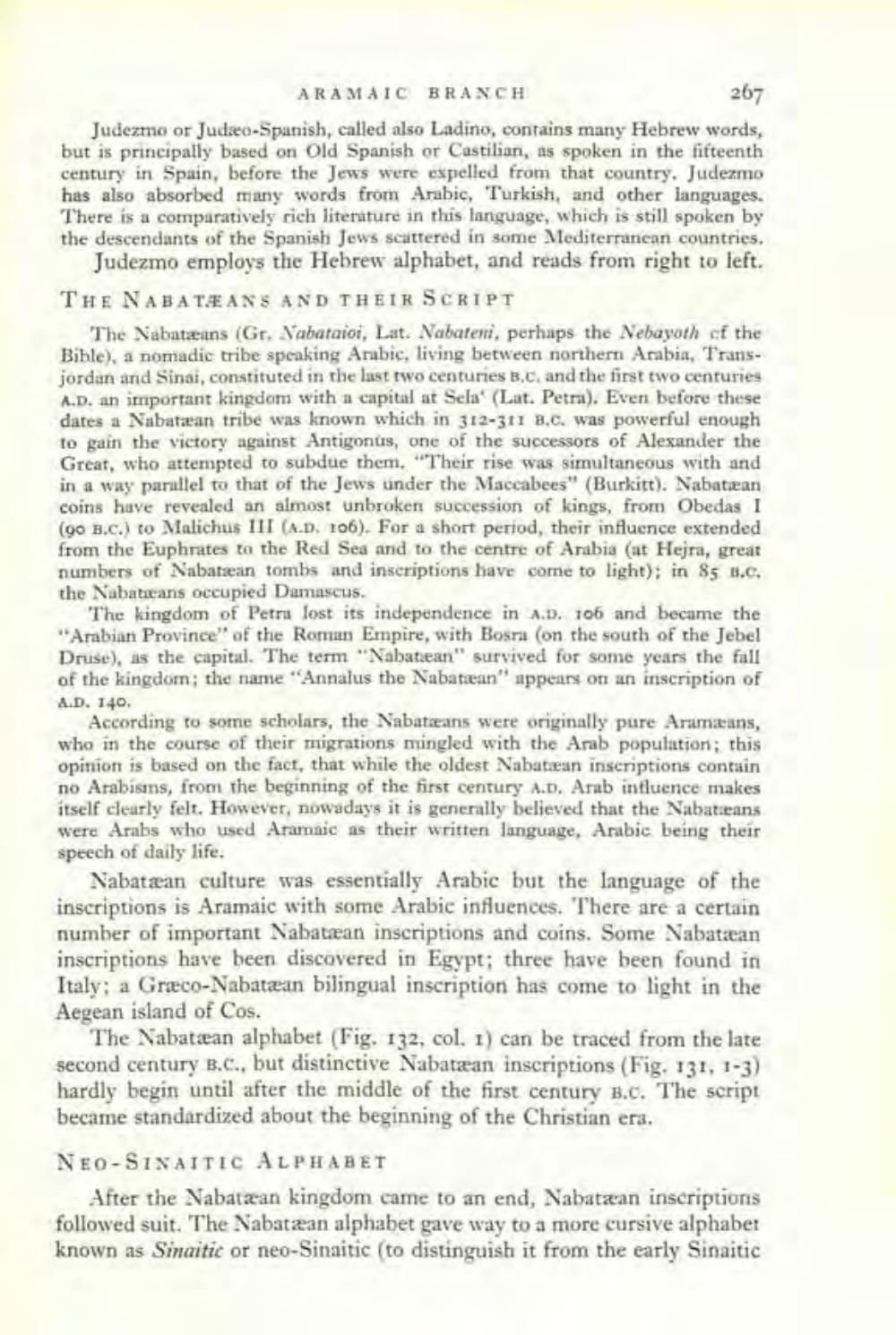________________
267
ARAMAIC BRANCH
Judezmo or Judæo-Spanish, called also Ladino, contains many Hebrew words, but is principally based on Old Spanish or Castilian, as spoken in the fifteenth century in Spain, before the Jews were expelled from that country. Judezmo has also absorbed many words from Arabic, Turkish, and other languages. There is a comparatively rich literature in this language, which is still spoken by the descendants of the Spanish Jews scattered in some Mediterranean countries. Judezmo employs the Hebrew alphabet, and reads from right to left. THE NABATEANS AND THEIR SCRIPT
The Nabateans (Gr. Nabataioi, Lat. Nabateni, perhaps the Nebayoth of the Bible), a nomadic tribe speaking Arabic, living between northern Arabia, Transjordan and Sinai, constituted in the last two centuries B.C. and the first two centuries A.D. an important kingdom with a capital at Sela' (Lat. Petra). Even before these dates a Nabatean tribe was known which in 312-311 B.c. was powerful enough to gain the victory against Antigonus, one of the successors of Alexander the Great, who attempted to subdue them. "Their rise was simultaneous with and in a way parallel to that of the Jews under the Maccabees" (Burkitt). Nabatean coins have revealed an almost unbroken succession of kings, from Obedas I (90 B.C.) to Malichus III (A.D. 106). For a short period, their influence extended from the Euphrates to the Red Sea and to the centre of Arabia (at Hejra, great numbers of Nabatean tombs and inscriptions have come to light); in 85 B.c. the Nabataeans occupied Damascus.
The kingdom of Petra lost its independence in A.D. 106 and became the "Arabian Province" of the Roman Empire, with Bosra (on the south of the Jebel Druse), as the capital. The term "Nabatean" survived for some years the fall of the kingdom; the name "Annalus the Nabataean" appears on an inscription of
A.D. 140.
According to some scholars, the Nabateans were originally pure Aramaans, who in the course of their migrations mingled with the Arab population; this opinion is based on the fact, that while the oldest Nabatean inscriptions contain no Arabisms, from the beginning of the first century A.D. Arab influence makes itself clearly felt. However, nowadays it is generally believed that the Nabateans. were Arabs who used Aramaic as their written language, Arabic being their speech of daily life.
Nabataan culture was essentially Arabic but the language of the inscriptions is Aramaic with some Arabic influences. There are a certain number of important Nabatean inscriptions and coins. Some Nabatean inscriptions have been discovered in Egypt; three have been found in Italy; a Græco-Nabatean bilingual inscription has come to light in the Aegean island of Cos.
The Nabatean alphabet (Fig. 132, col. 1) can be traced from the late second century B.C., but distinctive Nabatean inscriptions (Fig. 131, 1-3) hardly begin until after the middle of the first century B.C. The script became standardized about the beginning of the Christian era.
NEO-SINAITIC ALPHABET
After the Nabatean kingdom came to an end, Nabatean inscriptions followed suit. The Nabatean alphabet gave way to a more cursive alphaber known as Sinaitic or neo-Sinaitic (to distinguish it from the early Sinaitic




